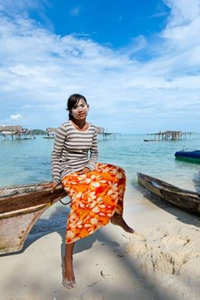Puhi people
| Regions with significant populations | |
|---|---|
| c. 150,000 | |
| Languages | |
| Puhi, Sublustrian pidgin | |
| Religion | |
| Wairua | |
| Related ethnic groups | |
| Sublustrians | |
This article is incomplete because it is pending further input from participants, or it is a work-in-progress by one author. Please comment on this article's talk page to share your input, comments and questions. Note: To contribute to this article, you may need to seek help from the author(s) of this page. |
The Puhi (Puhi Maohi), or the Moray tribe, are an itinerant population of Sublustrian origin. Also known as Oceanic Savaders or Sublustrian Savaders, the Puhi are famous for their nomadic, seaborne lifestyle, traveling between Sublustrian archipelagos in flotillas and docking in permanent settlements across the ocean. The Puhi build stilt villages in shallows and reefs as communal anchorage and mooring points, however they are also known to dock in settlements outside of their communities as well.
The origins of the Puhi are uncertain, but they were an established caste at least by the Early Modern Era. The relative scarcity of Ronorono texts prior to this era make a scholarly evaluation of their origins difficult. It is most commonly believed that the Puhi were originally fishermen and merchants who, with the rise of the Celestial Empire and its tributary network, began to engage in long-distance trade. Whether this was inspired by the various tribute ceremonies of imperial subject states or if they are both representative of older Sublustrian traditions predating both is unclear, but comparative analysis in related non-Sublustrian groups favors the latter theory.
The distinctive lifestyle of the Puhi has lent itself to a unique tradition of certain crafts, most famously their house-boats and stilt-villages. Their oceanic lifestyle also lends itself to the common use of marine materials for everyday purposes, including instruments of sharpened fish bone, aquatic leathers, and a unique body paint for the purpose of protecting from the sun. The intricacy and uniqueness of Puhi crafts has been traditionally popular in Sublustria, and holds a market in the region's tourism industry today.
Ethnonym
The word Puhi in both Yocatullic and Puhi means "Moray eel", hence the alternative translation, the Moray tribe, provided in some contexts. While it is uncertain when this name came to be the dominant form of reference to the Puhi, it carries significant symbolic weight in Sublustrian society, and has been a point of contention. The Puhi people are traditionally rivals of the Shark Clan prevalent throughout Sublustria, with totemism sometimes being offered as an explanation or origin myth for this relationship. The Shark Clan and the Puhi themselves offer competing narratives of the origin of the name, and with their debate carries several other questions such as the potentially derogatory nature of the name and a lack of alternatives offered.
According to the Puhi narrative, the name originates from a simple observance. While they claim the Moray as their totemic animal, they claim it was the similarities between their lifestyles that gave rise to the name and identification. The Puhi claim that, as the Moray lives in shallows and then retreats to the deep sea to breed, they anchor and dwell amidst reefs and shorelines between periods of long marine voyages. This explanation, though often considered probable as an origin of self-identification, fails to consider the possibility that the name was already present before such a lifestyle was adopted, and assumes that the totemic identification only began after this point.
The Shark Clan claims a different origin of the Puhi, stating that the name had always been known to them and their ancestors, even in a time when they were land-dwellers. According to the Shark narrative, the name was applied to them in a derogatory fashion. The derogatory intent supposedly stems from their reputation as 'slimy', 'slippery', 'predatory', and in some tellings 'parasitic', although this would align better with a lamprey than a moray. While the Puhi have faced a level of discrimination historically and held such a reputation at times, this etymology is generally considered unlikely, and fails to explain the aspect of self-identification despite explaining a longer history behind the name.
A third theory has been proposed by Sublustrologists and is reported to have been held by third parties historically, stating that the name's origin is simple totemic identification and nothing more. In the same way that the Shark Clan is referred to on occasion as the Shark Tribe, or how the imperial family has the moon prefixed to their names, this explanation is considered to explain the widest range of factors and has precedent elsewhere in Sublustrian society. According to this theory, the Shark Clan's derogatory use stems from their rivalry, and is parallel to slurs derived from common usage elsewhere in the world, while the incidence of the lifestyle explanation by the Puhi may be either of imitative origin or simply coincidental. If imitative, it would also provide an explanation for the origin of their nomadic habits when proto-Sublustrian society was agrarian.
